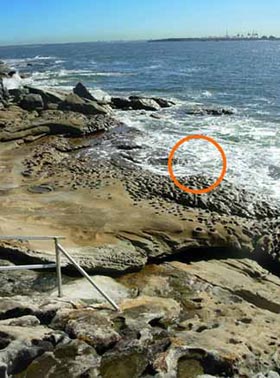The Steps
Home Of The Weedy Seadragons
| The Steps | |
|---|---|
| Site | A beautiful site with sponge gardens, seadragons and much more |
| Experience Level | Open Water |
| Max Depth | 18m |
| Warnings | Start the dive swimming into the tide as the current can be strong |
| Conditions | Protected with exposure to E to ESE swell greater than 1m. |
| Location | Kamay Botany Bay National Park, |
The Steps is a great dive site, especially if you want to see weedy seadragons. During slack tide (or an incoming current) is the best time to dive. Once you're in, head north until you reach the sand line. To the east (heading out of the bay), after some kelp, the dive opens up into many rocks covered in sponges with all sorts of fish life. To make a change of scenery on the way back, you can head into shore and the scenery becomes dense with large boulders; a great place for giant cuttlefish to be hiding out. The west of the entry/exit point can also be done as a dive. Depending on the tide, you can do a drift dive from the Steps around to Sutherland Point or the Monument. To the west of the entry point is large boulders, some sponge covered rocks and some interesting swim-throughs. The Steps Kurnell is also a great spot to see Weedy Seadragons. The swirling Kurnell tide has all the favorable water currents and temperatures to offer you an adventurous dive.
Details
After entering, swim out for about 15-20 meters and descend into the 4-meter deep water onto a dense collection of boulders that abruptly stop at 6 meters depth along an east/west line. The boulders meet the sand and are bordered to the east and the west by kelp (about 15 or so meters away on each side).
Remember this on your return leg – the absence of kelp is your sign to head south to the boulders and the exit. Depending on the tide (swimming into for the outward leg), head east or west. East will take you past kelp (and a plethora of weedy sea dragons) into slowly deepening waters – your turnaround time will usually occur at the 16-metre mark. To the south is a line of boulders that runs about 5 metres thick, beyond which is an expanse of sand sparsely populated with kelp and boulders. This sand meets a wall of boulders at about 5 metres depth which runs parallel to shore. If air time is low, it’s well worth considering following this wall on the return leg.
The west takes you past a large stand of kelp, then over a collection of boulders that leads out from the wall. These boulders separate the wall from the expanse of sand goes beyond to the north. Between this wall and the boulders, you can encounter a number of nice swim-throughs and a diversity of aquatic life. Eventually, the wall becomes steeper and more defined as you move towards the boundaries of the ‘Monument’ dive site.
The Steps Dive Site

Entry and exit
To reach the dive site, follow the main park road past the turn-off to the Discovery Centre and the car-park for Steps is on your left. In the middle of the fence is an opening that leads down past a warning plaque in roughly-hewn, large steps. A viewing platform is on your left as the path twists around to the right, becoming very narrow and bending to and fro down steel steps, a steel bridge that leads to the west and eventually the entry point. A large expanse of bedrock encircles an enclosed section of water, bordered to the north by two boulders. Facing the water, the right (eastern) side of this enclosure has a ledge that extends out. This is the entry point. At high tide, make sure you time between the sets and perform a belly flop entry heading out to the right of the main boulder (see map). At low tide, a controlled seated entry may be more suitable. This also serves as an exit point. If the swell and/or the tide is up; the "v” shaped groove at the back of the enclosure can also be used.


Critters
|
Blue grouper |
Sea horses |
Various sponges |
|
Goat fish |
Various wrasse |
Various nudibranchs |
|
Giant cuttlefish |
Port Jacksons |
Morwong |
|
Morays |
Dwarf pipehorses |
Velvetfish |
|
Gurnard |
White ear |
Sponge crabs |
|
Weedy seadragons |
Turtles |
Various rays |

